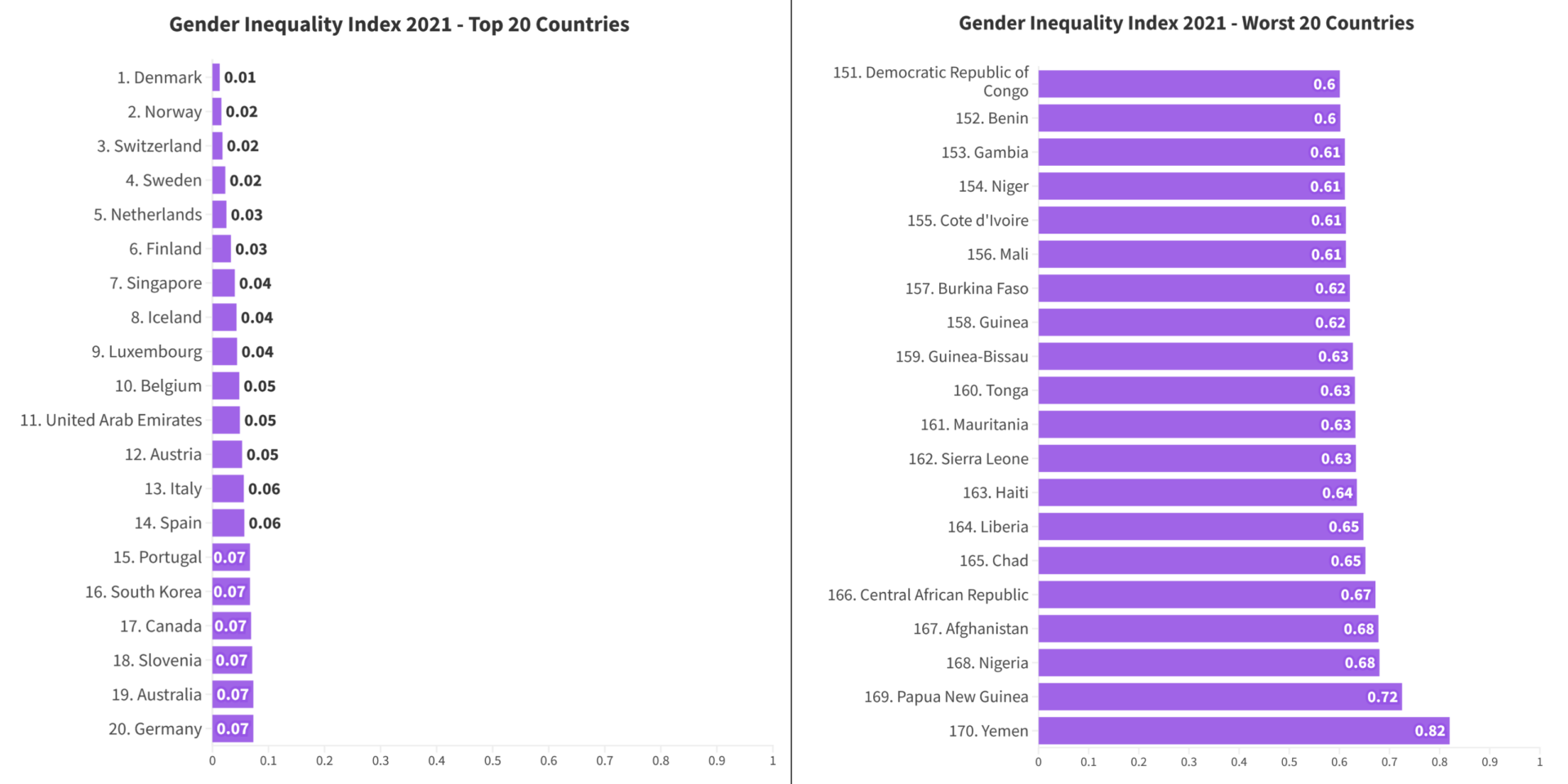What are the top countries for gender equality?
Written by Olivia Nater | Published: March 8, 2024
The world is still far from achieving gender equality, with some countries doing a lot better than others. On International Women’s Day, we take a look at which nations have the highest gender equity scores based on reproductive health, education, as well as participation in the labor market and decision-making.
Inching forward and sliding backward
While the women’s rights movement has celebrated many major victories over the past century, women are still a long way from achieving the same opportunities, rights, and freedoms as men.
Not a single country has achieved full gender equality, and no woman is safe from the threat of discrimination, harassment, and gender-based violence. In many developing countries, women and girls still routinely face horrific injustices, including female genital mutilation, forced marriage, and high levels of domestic and sexual violence. Even in some high-income countries, the rise of the far-right and religious fundamentalism has led to regression on reproductive rights, such as U.S. women losing access to safe abortion care in many states as a result of the 2022 Supreme Court ruling that overturned Roe v. Wade.
The most recent annual UN report analyzing progress on gender equality across all 17 Sustainable Development Goals (SDGs) notes,
“Active resistance to gender equality and chronic underinvestment are key factors in slow progress and, in some cases, reversals of gains already made.”
Women’s empowerment is one of the most underfunded areas of development. The United Nations Population Fund (UNFPA) estimates that there is funding gap of $222 billion for ending the worst gender inequalities by 2030, including gender-based violence, child marriage, preventable maternal mortality, and unmet need for contraceptives. A separate analysis by the UN Conference on Trade and Development (UNCTAD) looking at SDGs related to poverty, hunger, health, and women’s participation in decision-making, among other things, estimates a shortfall of $360 billion per year for achieving gender equity in these SDG areas in 48 priority developing countries. The theme for this year’s International Women’s Day, Invest in women: Accelerate progress, is thus very relevant.
The countries that take women’s rights seriously
Let’s take a look at the countries that have so far achieved the most progress on women’s rights, based on the UN’s Gender Inequality Index (GII). The GII is a composite metric that measures maternal mortality, teen births, secondary education attainment, share of parliamentary seats, and labor market participation. It ranges from 0, which means women and men fare equally, to 1, where women are as disadvantaged as possible in all measured dimensions. Another prominent gender equality index is the World Economic Forum’s (WEF) Global Gender Gap Index, but this one does not include any measure of reproductive health and rights, so we are not using it here. It’s also worth noting that incomplete and missing data makes it difficult to paint a holistic picture of a country’s level of gender equality, and even the UN’s GII does not account for some major gender issues, such as gender-based violence.
1) Denmark
 Nordic countries usually come out on top for measures related to gender equality, and the GII is no exception. Denmark has the best GII score based on the most recent data (2021), at 0.013. This country has a maternal mortality rate of four maternal deaths per 100,000 live births and an adolescent birth rate of 1.9 births per 1,000 girls aged 15 to 19; 39.7 percent of Denmark’s parliamentary seats are held by women; 95.1 percent of Danish women aged 25 and older have received secondary education; and 57.7 percent of women aged 15 and older participate in the labor force, compared to 66.7 percent of men.
Nordic countries usually come out on top for measures related to gender equality, and the GII is no exception. Denmark has the best GII score based on the most recent data (2021), at 0.013. This country has a maternal mortality rate of four maternal deaths per 100,000 live births and an adolescent birth rate of 1.9 births per 1,000 girls aged 15 to 19; 39.7 percent of Denmark’s parliamentary seats are held by women; 95.1 percent of Danish women aged 25 and older have received secondary education; and 57.7 percent of women aged 15 and older participate in the labor force, compared to 66.7 percent of men.
Did you know?
The world’s first female minister was appointed in Denmark — Nina Bang became Minister of Education in 1924. Denmark appointed its first minister for gender equality in 1999, and the first Danish female Prime Minister came into office in 2011. The current Prime Minister, Mette Frederiksen, is also a woman.
2) Norway
Norway is close on the heels of Denmark, in second place for GII, with a total score of 0.016. Norway has an even lower maternal mortality rate than Denmark, at just two deaths per 100,000 live births, but its adolescent birth rate is slightly higher, at 2.3 births per 1,000 girls. Women hold 45 percent of parliamentary seats in Norway, topping Denmark, and an impressive 99.1 percent of women have received secondary education. 60.3 percent of Norwegian women participate in the labor force, compared to 72 percent of men — a larger gap than in Denmark.
Did you know?
Norway is a major supporter of international sexual and reproductive health and rights (SRHR) and has developed extensive action plans for advancing gender equality across the world. According to the most recent available data (from 2022), Norway is the second biggest contributor (after Sweden) of core (unrestricted) funding to UNFPA, the UN’s SRHR agency.
3) Switzerland
 Switzerland holds third place for GII, with a score of 0.018. It has a maternal mortality rate of five deaths per 100,000 live births, and its adolescent birth rate is 2.2 births per 1,000 girls. Women occupy 39.8 percent of parliamentary seats, and 96.9 percent of women have received secondary education. Swiss women’s labor force participation is 61.7 percent, versus 72.7 percent for men.
Switzerland holds third place for GII, with a score of 0.018. It has a maternal mortality rate of five deaths per 100,000 live births, and its adolescent birth rate is 2.2 births per 1,000 girls. Women occupy 39.8 percent of parliamentary seats, and 96.9 percent of women have received secondary education. Swiss women’s labor force participation is 61.7 percent, versus 72.7 percent for men.
Did you know?
Switzerland had a bit of a slow start when it comes to women’s rights. Swiss women weren’t granted the right to vote until 1971, after a failed referendum in 1959 — more than 50 years after the U.S. and Germany, and more than 25 years after France, Italy, and Austria. Nevertheless, Switzerland is a remarkably safe country for women, ranking second out of all countries (behind Denmark) in the 2023/34 Women’s Peace and Security Index. This index takes into account intimate partner violence, community safety, political violence targeting women, and proximity to conflict, as well as several inclusion and justice indicators.
4) Sweden
In fourth place for GII is Sweden, with a total score of 0.023. This Nordic country’s maternal mortality rate is four deaths per 100,000 live births, and its adolescent birth rate is 3.3 births per 1,000 girls. Women in Sweden hold almost half (47 percent) of parliamentary seats, and 91.8 percent of women have received secondary education. Swedish women’s labor force participation is 61.7 percent, compared to 68 percent for Swedish men.
Did you know?
Sweden was the top contributor to UNFPA’s core funding in 2022, and has long been a pioneer of gender equality. In 1974, Sweden was the first country in the world to replace maternity leave with gender-neutral parental leave — the policy allowed parents to take six (paid) months off work per child, with each parent entitled to half of the days. The country followed up with additional policies to encourage more fathers to engage in parenting duties.
5) Netherlands
 The Netherlands is ranked fifth for GII, with a score of 0.025. This country has a maternal mortality rate of five maternal deaths per 100,000 live births and an adolescent birth rate of 2.8 births per 1,000 girls; 39.1 percent of the Netherlands’ parliamentary seats are held by women; 89.8 percent of Dutch women have received secondary education; and 62.4 percent of women participate in the labor force, compared to 71.3 percent of men.
The Netherlands is ranked fifth for GII, with a score of 0.025. This country has a maternal mortality rate of five maternal deaths per 100,000 live births and an adolescent birth rate of 2.8 births per 1,000 girls; 39.1 percent of the Netherlands’ parliamentary seats are held by women; 89.8 percent of Dutch women have received secondary education; and 62.4 percent of women participate in the labor force, compared to 71.3 percent of men.
Did you know?
The Netherlands is one of a handful of countries that have adopted a feminist foreign policy, meaning equal rights and equality are the main focus of all aspects of Dutch foreign policy. The country is the fifth biggest donor to UNFPA core funding.
How do other countries score?
The remaining top 10 countries for GII are Finland in sixth place, Singapore in seventh place, Iceland in eighth place, Luxembourg in ninth, and Belgium in tenth.
The 10 countries with the worst GII scores are, in descending order, Mauritania, Sierra Leone, Haiti, Liberia, Chad, Central African Republic, Afghanistan, Nigeria, Papua New Guinea, and Yemen, which is ranked last among countries with available data.

How does the U.S. rank for gender equality?
The United States is unfortunately pretty far down the list for GII, in 44th place. The U.S. has a high maternal mortality rate for a high-income country, with 19 deaths per 100,000 live births. It also has a relatively high adolescent birth rate, at 16 births per 1,000 girls. Women hold only 27 percent of congressional seats, and just 55.2 percent of women aged 15 and older participate in the labor force, compared to 66.4 of men. The U.S. scores highly for education, however, with 96.5 percent of women having received secondary education.
Celebrate achievements, keep pushing for change
This International Women’s Day, let’s celebrate the countries that are investing in and prioritizing women’s rights domestically and around the world. Let’s also call on world leaders everywhere to support gender equality and SRHR and ensure women and girls in all countries are no longer left behind.

